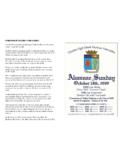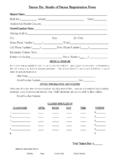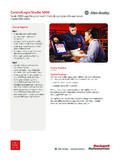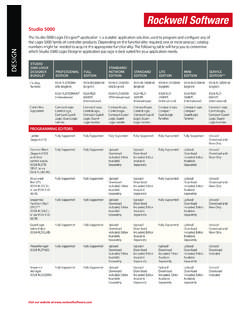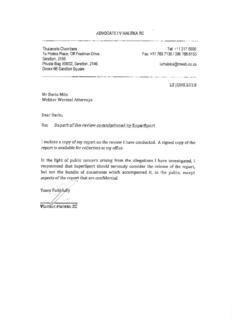Transcription of AP STUDIO ART SUMMER ASSIGNMENTS - …
1 M. Bryant Ursuline High School AP STUDIO Art SUMMER Work 2009 Contact info; mobile 707 481-3415 AP STUDIO ART: SUMMER ASSIGNMENTS : 2D Art 3D Art Drawing The following pages have a vast selection of SUMMER ASSIGNMENTS for you to choose from. As an AP STUDIO artist, you are expected to submit quality artwork that can be comparable to artwork produced at the college level. Your SUMMER assignment involves a time commitment of about 2-5 hours a week. They are vital to the development of your AP Portfolio. It will add to the required AP sections: Quality, Concentration, & Breadth. In some cases, it will be a realization process for you to understand yourself better as an artist.
2 You are expected to create 6 high quality, well- thought out pieces of completed artwork throughout the SUMMER and keep a sketchbook to document the progress and concepts behind your artwork. 3 projects are due by July 15 at the Ursuline High School front desk. If you do not complete these you will not be in the course. The other 3 are due at the start of the school year. CHOOSE any SIX (6) of the ASSIGNMENTS in packet. Three (3) are to be completed by July 15. Three (3) more are to be completed by the 1st day of school. Digital pictures will be made of all works to be considered for AP Portfolio Judging. Please start taking digital images of the work you complete.
3 We will go over this next semester. 1. All 3D Portfolios in AP STUDIO Art are judged by images only. 2. For AP STUDIO Art in 2D & Drawing, the judging process includes a blend of images and original works. *Your work surface can be no larger than 18 x 24 in order for the original works to be sent for AP portfolio judging. M. Bryant Ursuline High School AP STUDIO Art SUMMER Work 2009 Contact info; mobile 707 481-3415 For more details about AP STUDIO Art Requirements, please see: 1. PORTRAIT / FIGURE CHOICES: A. PORTRAIT: METAMORPHASIS! Step 1. BRAINSTORM WITH LISTS: If you could be anything or anyone in the world, who or what would you be?
4 List 10 things you would change into and the reasons for your choices. Step 2. PHOTOGRAPH YOURSELF & WHAT YOU D CHANGE INTO. Get a total of 24 shots of yourself and the object/person you would like to change into. It can be any combination. You can use a tripod and/or get help from a friend to shoot self-portraits. Remember that you will need to get a signed release form from the photographer, if it is not yours, and that you are not to use copy written images from the internet or books (AP guidelines are strict.) Step 3. EXAMINE THE PHOTOGRAPHS FOR TRANSITION: Set aside 6 8 strong candidates that show transition without strong jumps. These will be the basis for a collage or sequence showing the transition.
5 Step 4. CREATE SIX SMOOTH TRANSITIONAL STEPS TO SHOW FINAL METAMORPHASIS. *What media do you feel comfortable in making the changes to these shots? *(Will photoshop be an appropriate choice for you to blend some of the images, distort them or tweak the color? *Do you need to use the photocopier as a tool to lighten or darken them, shrink them, enlarge them, or blur them? *Do you need to touch them up with pencil to strengthen the sequence of change. *Do you need to tear and collage the images together add watercolor, oils, tempera, or acrylic. Step 5. FINAL WORK WILL BE EITHER A SEQUENCE OF IMAGES OR A COLLAGE IMAGE. Size will vary but likely include 3 to 5, 8x10 digital images, or a 14 x 17 or 18 x 24 mixed media work.)
6 M. Bryant Ursuline High School AP STUDIO Art SUMMER Work 2009 Contact info; mobile 707 481-3415 B. PORTRAIT: IMAGE MAKEOVER! Step 1. BRAINSTORM WITH A CAMERA FOR IDEAS: In photography, you are always dealing with a defined format that you compose from within. Many times, it is not the subject that makes the photograph interesting, but the compositional choices the photographer has made. Choose a simple, neutral background/ backdrop (black, white, grey, or tan) for you to photograph someone s head 24 times. You may include one hand. Take one boring shot that captures the whole face frontally as a before example. Then strive to make each of the 23 shots completely different and interesting.
7 ? It may help to explore composition with a paper view finder first to examine the possibilities available, before you photograph the person. Vary the poses by changing the face s position and scale. relationship to the edge, degree of cropping ( ), vantage point (photographed from low), etc. How do these changes of scale, cropping, and vantage points affect how others perceive this portrait? Step 2. LOOK FOR A UNIFYING THEME: Print out the 24 photos as source material . These can be thumbnail size. Examine them and ask What relationships do I see by putting one next to the other? Where is the visual weight in each photo? What variations in scale do I see?
8 Where is the viewer being positioned? What tone or mood is being set? You may manipulate the photos after developing them in any way that you want: crop them, scan them in, and duplicate them, photocopy them for repetition, add drawn elements to them. Remember that visual unity extends to material choice. That means that you can use pencil, oil paint, acrylic paint, water color, ink, colored pencils, chalk pastels, charcoal, collage materials, I would keep the number of media used to a minimum, not mixing too many elements. For surface unity, you may consider scanning in the final product and printing it (use thicker stock). You must use at least three photographs in your final piece.
9 Step 3. CREATE the FINAL PORTRAIT. The presentation of the piece and the format is your design decision. Some options are: *PRESENTING AS PROGRESSION. (2D) You may approach your portraits as a progression, placing three or more in a sequence that either implied movement or takes advantage of contrast, various M. Bryant Ursuline High School AP STUDIO Art SUMMER Work 2009 Contact info; mobile 707 481-3415 angles, or scale shifts. Or possibly arrange them in a grid instead of a line. Think about spacing. Should there be room between each piece or not? If so, how much? Also consider the size of you outside borders. *PRESENTING INDIVIDUALLY. (2D or 3D) Sometimes the pieces (like the shapes in your progression) improve significantly when combined with others.
10 Other times a singular photo seems a complete composition or idea in itself; therefore, another option is to mount each photo (minimum of three) individually. Remember that they will still be perceived as a unit, and therefore must have some synergy between them. You may mount them, create a three-dimensional cube, make them into a book of some sort, create a playing card deck complete with a storage box. Be inventive, without letting the presentation itself overpower the images. You should strive for a mutually beneficial relationship between the image and the presentation. *PRESENTING AS A COLLAGE. (2D) You may approach the photos as source material for a collage.
